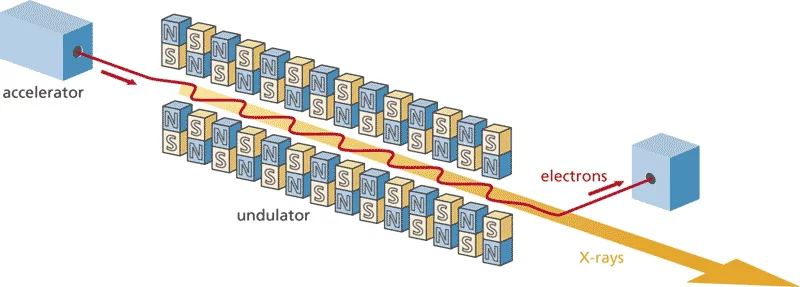- the injector (and electron gun), in which the electron beam is generated and accelerated close to the speed of light;
- the linear accelerator (linac), where the electron beam gains further energy;
- the undulator, a periodic array of magnets along which the electrons are forced to emit x-rays;
- the experimental stations in which the X-ray beams are used to perform experiments on samples.
At SwissFEL, the injector consists of a photo RF gun to produce the electron beam. A laser knocks out electrons from a metal surface, which are then accelerated by the electric field in the RF cavity. A good electron gun must produce a narrow beam in which the electrons do not strive apart from each other. This quality is described by the emittance which is the product of beam width and beam divergence (the spread angle of the beam). A low emittance is critical for eventually obtaining the wanted tightly focused and intense X-ray beam while keeping the length of the linear accelerator within a reasonable range. Keeping the emittance low is also the purpose of the fast acceleration between the electrodes mentioned before. By bringing the electrons into the relativistic regime (velocities close to the speed of light), the mutual repulsion between them can be overcome, which prevents the beam from flying apart.
After exiting the injector the electron beam enters the linear accelerator (linac), a 400 meters long straight line along which the electrons energy is boosted up to 6 Giga electron Volts (GeV). The SwissFEL design foresees acceleration through radio frequency cavities made of copper. In these cavities, the field of the electromagnetic wave carries the electrons from one cavity to the next, like a surfer on the crest of a wave. In order to keep the overall size of the linac short, the RF-cavities of SwissFEL works at a frequency of 6 GHz. Such a high frequency imposes tight constraints on the tolerances within which components must be made and aligned, thus it represents a challenging task for engineers. Along the path of the linac the electron bunches will be further compressed in the longitudinal direction. This is necessary as the electrons will leave the injector in fairly long bunches with a time difference of some picoseconds between head and tail. The bunches must be compressed to some femto seconds, however, in order to let them radiate equally, long X-rays pulse as they fly through the undulator.
After having been accelerated to almost 6 GeV, the electron bunches are now sent into an array of alternately poled magnets which will deflect them into a wavy path. This curved motion will induce the electrons to radiate away energy in form of X-rays. Under normal conditions, the radiation thus emitted would add up linearly, which means that the intensity of the emitted X-ray beams would grow with the number of emitting electrons. However, in the SwissFEL concept, a phenomenon called self-amplified spontaneous emission (SASE) will cause the intensity to scale up with the square of the number of electrons involved. This is due to the interaction between the electric field of the radiation and the emitting electrons. Inside the undulator, the electrons get bunched up into thin slices (micro bunching), which cause the electrons in a slice to radiate the much more intense ultrashort (femtosecond) pulses of hard X-rays, which are the salient feature of a free-electron laser.




